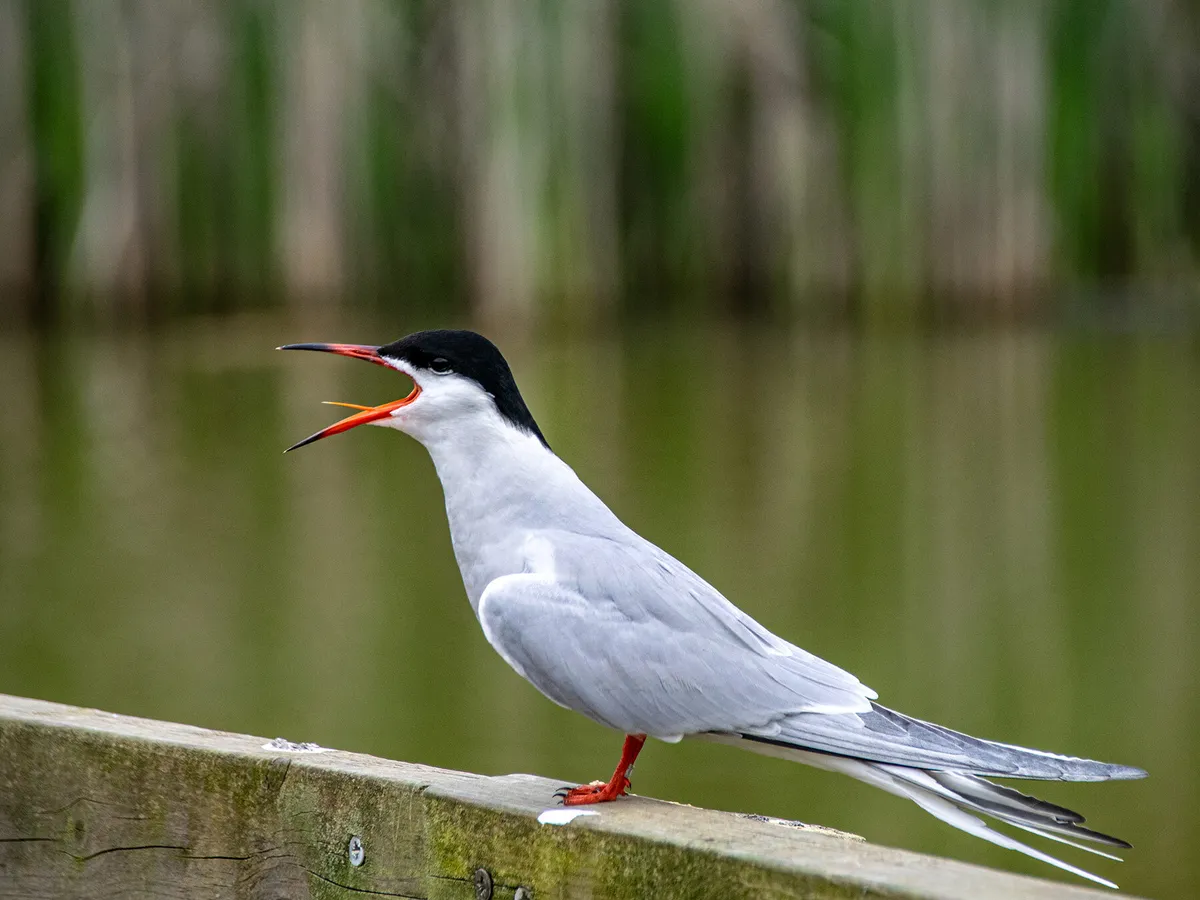Terns, members of the Sternidae family, are remarkable aquatic birds renowned for their exceptional fishing abilities.
With approximately 45 species distributed across the globe, terns possess distinct physical characteristics that set them apart from gulls. Sporting slender bodies, elongated tails, and comparatively shorter legs, these avian marvels embark on extensive migratory journeys, traversing great distances in pursuit of favorable habitats and resources.

'The Common Tern is a bird that is similar in size to the Arctic Tern. During the summer, adult Common Terns have silver grey upperparts and pale grey underparts. They have a black cap that extends from the base of the upper mandible through the eye and across the head. The chin and face are white, and the bill is long, thin, and bright red with a black tip. The primary flight feathers are dark grey to black, while the tail feathers appear to be the same length as the wing tips when folded. The upper tail and rump are white, and the longer outer feathers of the forked tail are edged in black. Underneath, there is a wide dark bar on the trailing edge of the wings and a white, translucent patch from the tips of the secondary flight feathers towards the flank.

The neck is relatively long, which is more noticeable when the bird is in flight. The legs and webbed feet are bright red. In the winter, the forehead and lores are white, while the rest of the cap remains black. The bill is black, and the shoulders are a dark grey, with streaks appearing on the outer wing areas. Male and female birds look similar, and juvenile birds have a predominantly grey appearance, with brown or light ginger barring on their upperparts.
They also have a dark grey nape and a greyish-brown crown with a buff-colored forehead. The shoulders are dark, similar to the adult’s winter patternation, and the rump is pale grey. The bill is dark grey with a pale pinkish base to the lower mandible, and the legs are a light browny-pink.

'Have you ever wondered what a Common Tern sounds like? These birds are quite vocal and use a variety of calls to communicate. They can even recognize their chicks and siblings based on their calls alone! One of their common calls is an alarm call that sounds like ‘kee-yah, kee-yah’, which can quickly quiet down a noisy flock or nesting colony. They also make a shorter ‘kyar-kyar-kyar’ call alongside it. When returning to feed their young, they make a distinct ‘keearr’ sound to alert them of their arrival. During social interactions with other terns, they use a simple ‘kik’ or ‘kik-kik’.

Have you ever wondered about the diet of a Common Tern? Well, this bird is mainly fond of fish, but it also likes to feed on molluscs, crustaceans, and insects. Typically, the Common Tern catches its food from the water by hovering and diving down to grab its prey or by swooping down and snatching it from the surface.''

''The Common terns have a wide distribution as they are migratory birds. They breed in various regions of the mid Palearctic area, spanning from Sweden to Central and Northern China through Russia and Kazakhstan to Kamchatka. Additionally, there are breeding populations on islands off the Northwest coast of Africa in the Atlantic.
In North America, they breed across Canada’s central and Southeast regions, extending to the Great Lakes and North East of the USA. During winters, the Eurasian breeding terns fly south to coastal areas of Africa, Indonesia, Malaysia, Papua New Guinea, the South Pacific Islands, North and East coast of Australia. The North American breeding terns travel south along the Pacific coastline of South America, reaching as far as Peru, across the Caribbean islands, down the Atlantic coast to Argentina, and even beyond.

The Common Tern is commonly found in coastal regions, but during breeding season, they can also be seen inland near rivers, lakes, and reservoirs. When migrating to tropical and sub-tropical areas, they tend to stay close to the coast and spend most of their time fishing in the ocean. These birds are social creatures that often gather in large groups or colonies, and they can be spotted roosting on sandbars, offshore islands, or both salt and fresh water marshlands. However, it’s essential to pay close attention to their plumage, behavior, location, and vocalizations as they can easily be mistaken for Arctic and Roseate Terns.''

The Common Tern has three sub-species, with the Sterna hirundo hirundo being the most widespread across North America, Europe, and Central Asia. The Sterna hirundo tibetana breeds in Central Asia up to the Tibetan Plateau, and its back and belly are a darker grey than the nominate sub-species. On the other hand, the Sterna hirundo longipennis is monotypic and breeds from Eastern Siberia through to North East China, migrating south to Australasia. This bird’s plumage is similar to the Sterna hirundo tibetana but has a black bill, making it easily identifiable in North America, where it can be seen as an occasional visitor to Western Alaska.''

During the breeding season, which usually spans from late April to June, Common Terns construct their nests on the ground using natural hollows, scrapes, or a combination of seaweed and stones. These nests are typically found in offshore colonies made up of sand, earth, or gravel. A typical clutch consists of 2-3 buff-colored eggs with dark splodges or streaks, which are incubated for up to three weeks by both parents. After hatching, chicks can stand and walk within hours and start wandering away from the nest after two to three days. However, they still rely on their parents for food. Fledging occurs between twenty-two to thirty days from hatching.''

Have you ever wondered about the lifespan of Common Terns? Well, these lovely birds often face predation from other birds, especially around their nesting sites. However, once they reach adulthood, Common Terns can live for up to ten years.



